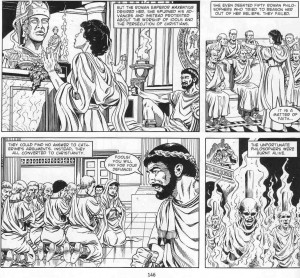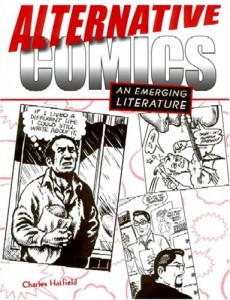On HU
Erica Friedman began the week with a discussion of the Bechdel Test and the manga Silent Mobius.
James Romberger wrote about the late horror comics of Alex Toth.
I used Laura Mulvey’s gaze theory to talk about Moto Hagio’s story “The Willow Tree.”
Richard Cook discussed St. Olaf’s appearance in the Big Book of Martyrs.
Vom Marlowe reviewed James Love’s Bayou.
And we finished the week out with the conclusion of our roundtable on Charles Hatfield’s Alternative Comics: An Emerging Literature. Charles himself has two posts (about his writing and rethinkings of his book, and about Gilbert Hernandez) and I had a reply because I’m incorrigible — and there are some spirited debates in comments as well.
Utilitarians Everywhere
At Splice Today I review some Roger Corman produced Alien knock offs just released to DVD.
But what’s most notable about these movies is not who gets killed, but who doesn’t. Because the greatest thing about Alien, the thing that gave it its real bite (as it were) wasn’t the gruesome beauty of its special effects or the brutal claustrophobia of its mise en scene… Or, okay, it was those things, I’ll admit. But it was also its twisted ruthlessness. Alien looked like a sci-fi film, but it walked like a slasher. Everybody in that movie was ruthlessly humiliated—especially the brave het heroes, who ended up raped, impregnated, violated, and dead, dead. The only one who gets out alive was that uber-final girl, Ripley, who was hard-assed and butch as hell, and when she left she didn’t need no stinking man, because (as I mentioned) all the men were dead.
Also at Splice I reviewed a new album by Eurodisco weirdos Majeure.
Long before Westerners had discovered philosophy, or even consecutive thought, the ancient Mayans were predicting a day in 2012 when Hegel’s brain would be uploaded to rotating satellites, creating a dialectical Skynet which would order the crucifixion of all humans and then broadcast impenetrable prose to their rotting corpses. Scientists today still wonder at the perspicacity of these ancient cultures, which—using nothing but the basest computers woven out of specially prepared obelisks—managed to predict the bloody demise of the hidebound print-based media, the rise of the cyborg antichrist Ke$ha, and the reverse rapture of materializing silly-bands which are even now drowning the world in a multi-colored kaleidoscope of hollow Platonic forms.
At Madeloud I reviewed Antony and the Johnsons new album.
Also at Madeloud a review of some depressive mopey but chimey black metal by Happy Days and Eindig.
Other Links
It’s good to be reminded now and then that before Gary was beloved and respected he was really, really, really loathed. (Our own Alex Buchet comments extensively on the very rancorous thread.)
Shaenon Garrity has been on fire recently. I kind of have no interest in ever reading Scott Pilgrim, but this review is awesome.




